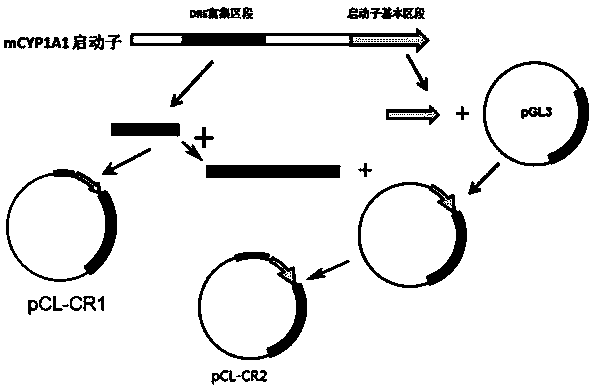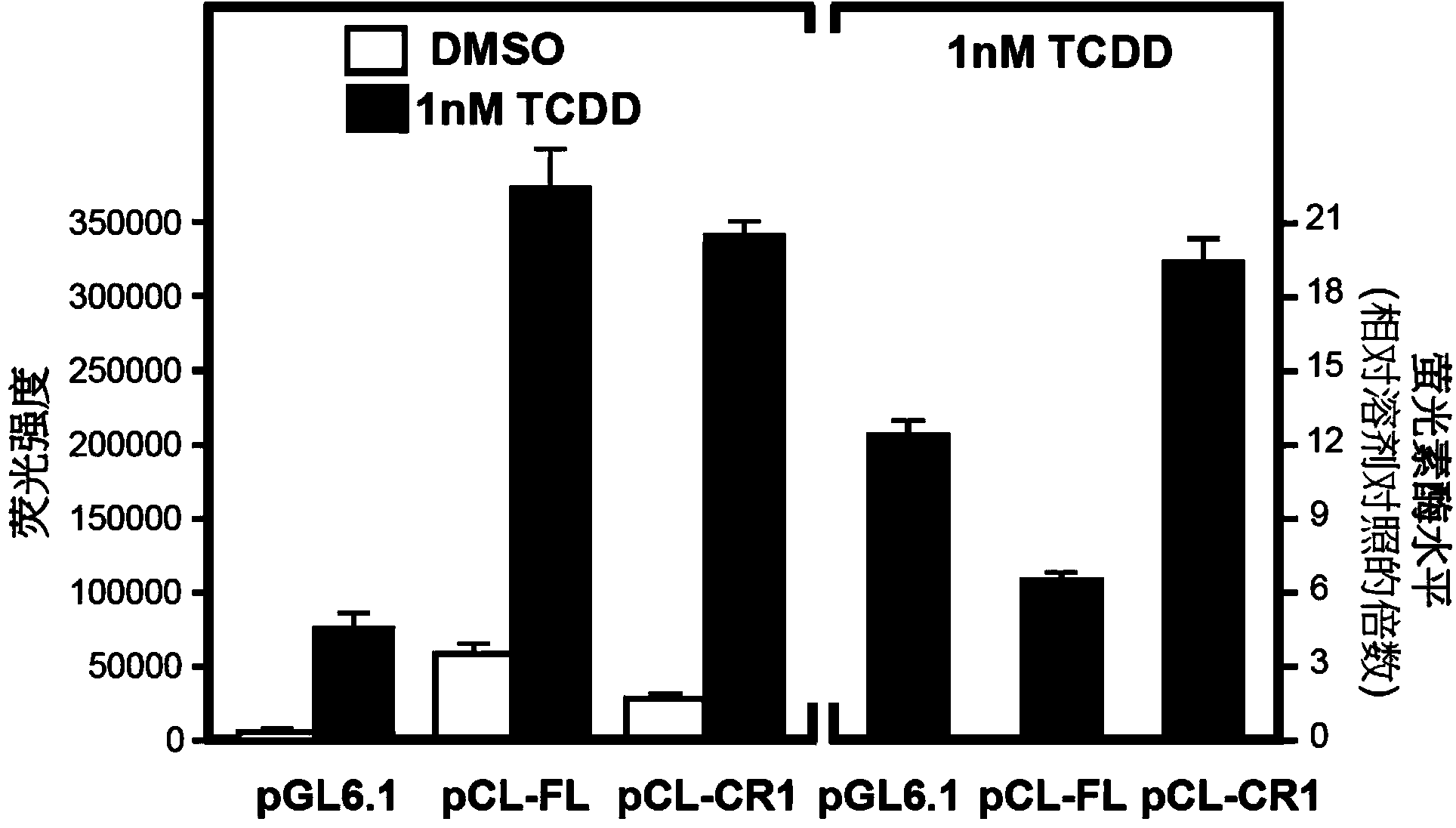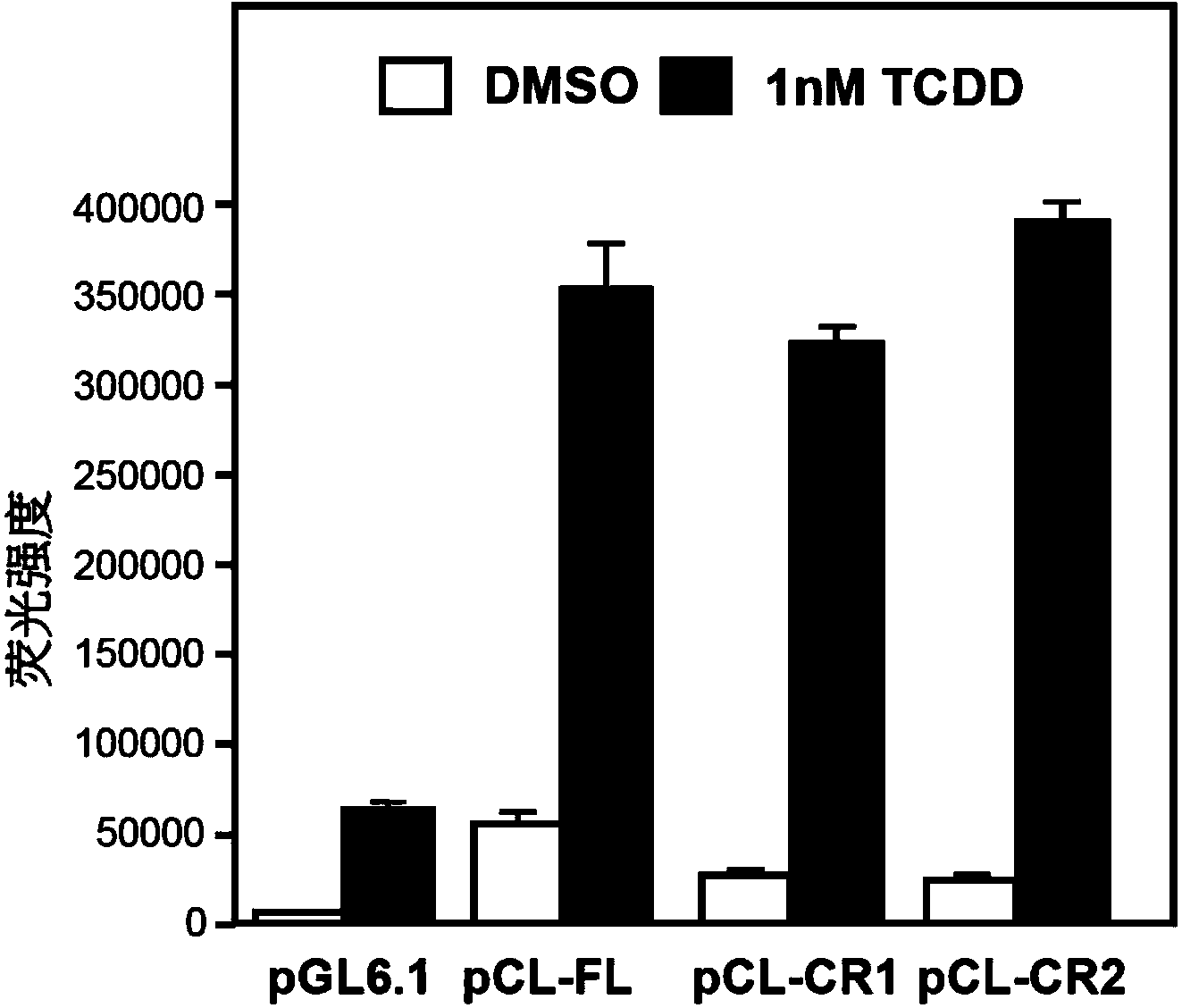Recombinant vector used for biologically detecting dioxin substances
A recombinant vector, dioxin technology, applied in the determination/inspection of microorganisms, the introduction of foreign genetic material using a vector, and the cells modified by the introduction of foreign genetic material, etc., can solve the problem of increasing the uncertainty of biological detection systems, MMTV promoter Area length and other problems, to achieve the effect of reducing detection cost, improving detection sensitivity, and reducing requirements
- Summary
- Abstract
- Description
- Claims
- Application Information
AI Technical Summary
Problems solved by technology
Method used
Image
Examples
Embodiment 1
[0051] Mouse genomic DNA was obtained from hepatocarcinoma Hepa1 cells and extracted according to the standard method of the kit.
[0052] 1. Construction of pCL-FL plasmid
[0053] Mouse genomic DNA was obtained from Hepa1 cells and extracted according to the standard method of the kit. And pCL-FL was constructed separately by standard molecular cloning means.
[0054] The purpose of this experiment is to construct a dioxin reporter gene detection plasmid including the original sequence of the mouse CYP1A1 promoter (-1400 ~ +3), which contains 6 DRE sequences. Using mouse genomic DNA as a template, a PCR reaction was performed with the following primers.
[0055] The 5' primer is: 5'-CACGCTCGAGAACAGGTTGAGTTAGAC-3' (SEQ ID NO: 1)
[0056] The 3' primer is: 5'-CACGAAGCTTCAGGGTTAGGGTGAAG-3' (SEQ ID NO: 2)
[0057] After the PCR fragment was obtained, it was digested with XhoI and HindIII, and the vector plasmid pGL3-basic was subjected to the same double digestion, and final...
Embodiment 2
[0095] Next Hepa1 cells were transiently transfected with pCL-FL or pGL6.1. Hepa1 was introduced into 24-well plates in equal amounts one day in advance, and the plasmid was transiently transfected with liposomes (LTX) when the cell density reached 50-80% the next day. That is, 0.5 μg of pCL-FL or pGL6.1 plus 1 / 30 of the amount of pRL-SV40 (control reporter gene, expressing Renilla luciferase, purchased from Promega) co-transfected cells for 18-24 hours (for the experimental method, refer to Promega double Luciferase reporter gene detection kit instructions). Then, according to the specific requirements of the experiment, the cells were stimulated with TCDD at a concentration of 1 nM for 4 h, and the cells were treated with the same conditions at a final concentration of 0.1% DMSO as a negative control. The cells were lysed, and the activities of firefly luciferase and Renilla luciferase were detected by a microplate reader with a double reporter method. Finally, the reactio...
Embodiment 3
[0098] The obtained plasmids pCL-FL, pCL-CR1 and pCL-CR2 were respectively transiently transfected into Hepa1 cells. Hepa1 was introduced into 24 empty plates in equal amounts one day in advance, and the plasmid was transiently transfected with liposomes (LTX) when the cell density reached 50-80% the next day. That is, 0.5 μg of pCL-CR1 or pCL-CR2 or pCL-FL plus 1 / 30 of the amount of pRL-SV40 (control reporter gene, expressing Renilla luciferase) co-transfected cells for 18-24 hours. Cells were then treated with α-MEM containing a final concentration of 0.1% DMSO or 1 nM TCDD (also at a final concentration of 0.1% DMSO) for 24 hours. Aspirate the medium and wash the cells once with PBS, then lyse the cells with 150 μl Promega lysis buffer for 15 minutes. Then pipette 20 μl of cell lysate into a 96-well white opaque microtiter plate, and repeat 3 times for each sample. Then, the reaction value of firefly luciferase induced by TCDD and the reaction value of the system control ...
PUM
 Login to View More
Login to View More Abstract
Description
Claims
Application Information
 Login to View More
Login to View More - R&D
- Intellectual Property
- Life Sciences
- Materials
- Tech Scout
- Unparalleled Data Quality
- Higher Quality Content
- 60% Fewer Hallucinations
Browse by: Latest US Patents, China's latest patents, Technical Efficacy Thesaurus, Application Domain, Technology Topic, Popular Technical Reports.
© 2025 PatSnap. All rights reserved.Legal|Privacy policy|Modern Slavery Act Transparency Statement|Sitemap|About US| Contact US: help@patsnap.com



